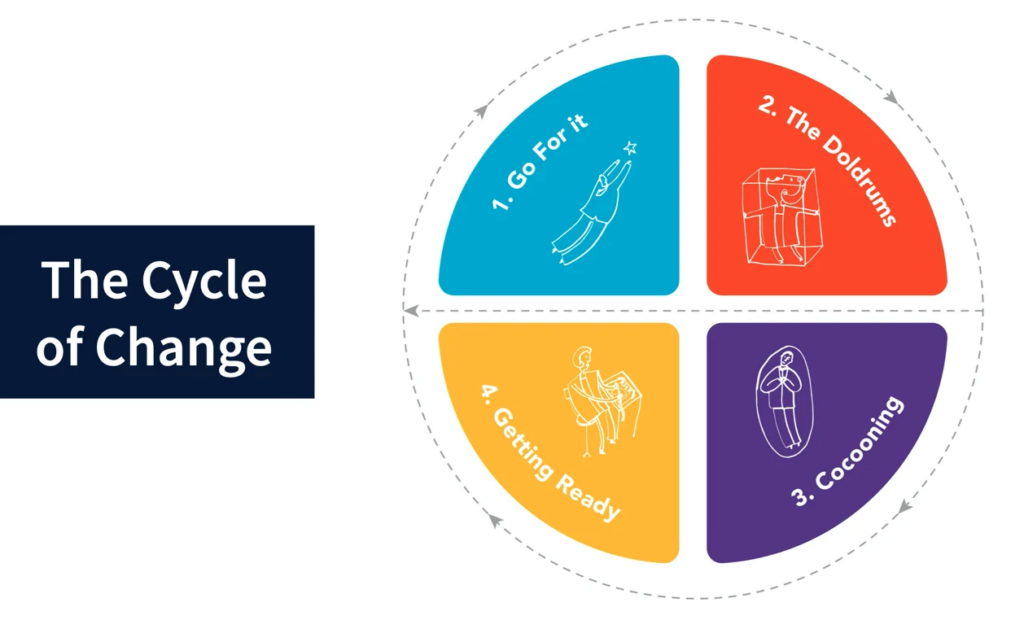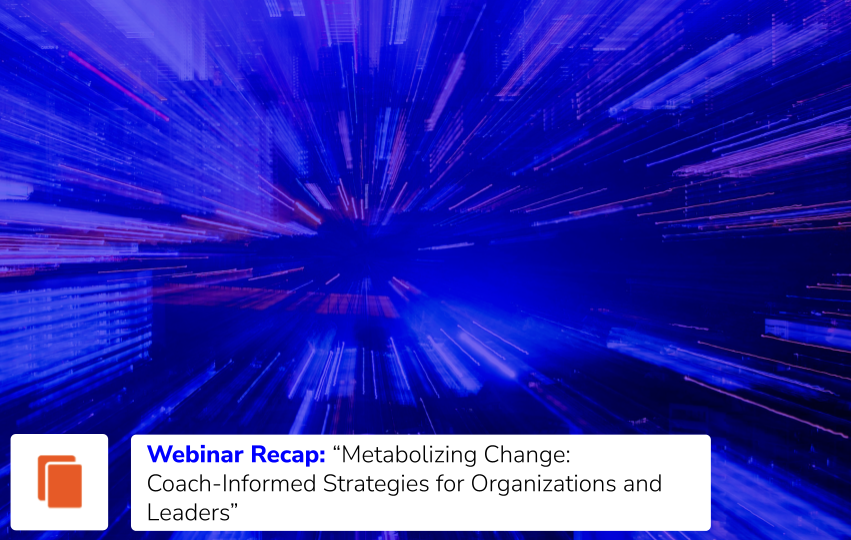How often in these strangest of times do you find yourself musing — what day is this? How long is this going to go on? Am I being careful enough? When will my old life return? The list goes on for all of us in small and larger ways – day in and day out.
We are all trying to traverse this murky expanse while facing losses, big and small; challenges, new and vexingly unpredictable; and disruptions, the likes of which we have never encountered before. We yearn for the old — the predictable rhythms of our pre-Corona lives — and we yearn for the new — a sense of forward progress. At Hudson, where we have been studying the patterns of transition and change in adult lives for 30 years, we have never experienced a time when the path forward is so unclear for so many.
Months living through this haze, many of us find ourselves still stuck in a morass of gooey quicksand, unable step forward. Uncertainties abound and while we won’t drown in quicksand as old movies once portrayed; the image surely illustrates the power of the shifting forces beneath our feet making it seemingly impossible to find our way back to stable ground.
Hudson has a well-used model, The Cycle of Change, which maps the ebb and flow of our adult years — the normative experience of longer chapters and shorter transitions unfolding; the heady times when all is seemingly perfect; the natural dips that remind us nothing lasts forever, signaling us changes are required; and those rare times when our identity shifts in significant ways and compels us to craft a new sense of meaning in a new time in life. Natural, cyclical, ever changing and deeply personalized for each of us in our particular context. And yet, in these times this well-tested model begins to break down.

We can’t see around the corner into our future nor can we engage in planning strategically for the next few years while this haze persists. How long will the pandemic continue? What will the long-term impact be on our children’s lives, our communities, careers, families, environment and our health? What will the impact be on our global economies? And how do we each find a way out of the quicksand and onto more stable ground?
Chances are, the quicksand will continue to draw us in unless we find small ways to pivot and re-orient, even while the future remains mostly a mystery. We’ve taken our Cycle of Change model and overlain a new concept that we began discussing back in May. This modified model incorporates the Corona Catastrophe and illustrates how we might adapt to pivot ourselves out of the quagmire and onto more stable ground.

Moving out of the quicksand calls for experimenting with small personalized actions that will allow us to reach the more stable ground of ‘Making It Work’ on the cycle of change. In these extraordinary times these pivots can help us step toward a place that feels more hopeful and offers us a sense of agency in these times. We pivot to find a bit of comfort — a new normalcy in these times. Here are some small pivots and practices you might be able to incorporate in order to feel less a casualty of this time and more an author of what’s possible in small yet important ways.
Pivoting matters. Pivots are little experiments and modifications. We can’t redesign our lives when there is so much unpredictability underfoot; but we can test out small adjustments that can help us reach higher ground that feels steadier. When we pivot, we take action and one or two small actions renews our sense of agency and hope. The pivots are likely wide-ranging for all of us – new activities for our kids to maximize virtual learning; new daily rituals making space for exercise and healthy food in the midst of our WFH routines; altered morning and evening grooves that serve to replenish and more.
In those spaces in your daily routines where you feel most bogged down, consider these questions:
- In the area(s) of my daily routine where I feel most challenged, how might you experiment with a small pivot? What might it be?
- In order to be at your best for yourself and others, you need to attend to your own needs (health, exercise, diet, solitude, etc). How might you experiment with one or two minor adjustments that might better meet these needs?
Planning in quarters, not years. We need to bring our time horizon closer than is comfortable. Most of us find planning a practical and helpful practice — whether a family trip in the coming year, a career trajectory that extends several years, a move to a new location in the future or something else; planning helps us set the course for the foreseeable future. Today it’s hard to see around the corner, let alone plan for something that is several months in the distance. When we try to plan for the future — a wedding date in 2021, a family reunion or a retirement party — we are thwarted because the unknowns are too great. Narrowing the horizon removes the continual ‘what if’ conversations and likely reduces anxiety as well. Thinking and planning one quarter at a time is possible, so give it a try. It just might allow all of us to be more present to the moment when we acknowledge we can’t see very far into the future in our world.
- As you look at plans you would like to make in the coming months, how might you draw the horizon closer?
- Experiment with a three month plan and see if it makes it easier to let go of the longer term plans for now.
Adapting more often. Look at how much we have adapted over the past six months. In pre-pandemic times we talked a good deal about disruption, yet we had no experience with a global disruption of this magnitude. We’ve all been disrupted — the depth is enormous for many and yet present for all of us. We’ve learned to adapt in impressive ways. At this stage our adapting is all about mindset, flexing to practical needs while cultivating our capacity to focus on what’s possible, see what’s good and nourish that at home and at work. Yes, we all know by now that the internet may go out as you prepare for an important call, a child may crawl in your lap in the midst of a key negotiation, repeating cycles of shelter at home may require new ways of getting some of the goods that are important in your life, and mindset makes the difference for ourselves and those we touch each day. Adapting keeps us resilient.
- As you scan your mindset over the past few weeks, are you in need of a time out and tune up? Just a conscious focus on the power of your mindset on daily life?
- Is there a morning mantra that could aid in shifting your mindset to look for what’s possible rather than what’s not?
Finding meaning in new ways. What matters most in these times? For many, the small things in our daily lives are more important than they once were. Growing tomatoes in a container, tucking the kids in at bedtime every night, spending more time with family when air travel is largely eliminated from schedules, making time for a morning or evening walk with a little more ease, extending a caring hand to others through words and actions.
Take an inventory of these past many months
- What is bringing you meaning today that is different from those ‘old normal times’?
- In what ways have you learned and grown since the pandemic?
- What’s possible today that wasn’t before?
By now, we’ve all found ways to cope, but if we find that solid ground and adjust our focus to what’s near us — what we can see through the haze — perhaps we can begin to thrive.




![[Video] Authors in the Field Ft. Peter Block](https://hudsoninstitute.com/wp-content/uploads/2025/09/Insight-blog-video-thumbnail-1.png)